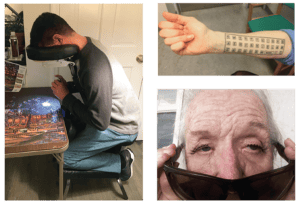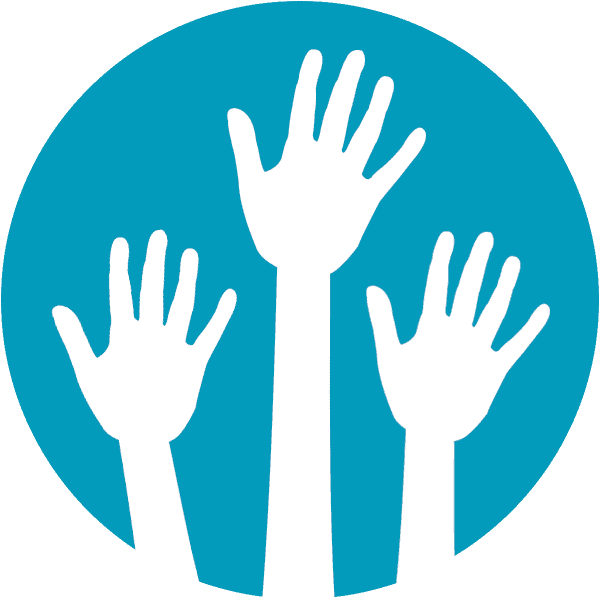Creative Coping: Tips & Tricks for Daily Life
This article was published in the Dystonia Dialogue.

Medical treatment for dystonia is available, but effectiveness varies. Few treatment options, on their own, provide 100% relief. Living well with dystonia often requires creative adaptations invented by those experiencing the disorder firsthand.
An international team of clinicians recently published examples of the “self-concocted, curious, and creative” ways movement disorder patients manage symptoms. The clinicians noted how important these coping techniques are to improved quality of life. In many ways, these homegrown strategies compensate for less-than-ideal medical treatment.
Among the most resourceful tricks, a patient with severe speech impairment due to neurodegeneration with brain iron accumulation tattooed a keyboard on their forearm to aid communication. While such an approach may initially appear extreme, it is a brilliant and economical self-made solution to a problem medicine could not heal—and without the need for equipment or technology.
Most of the innovative patients highlighted in the paper were individuals with dystonia. An individual with spine and neck arching found that wearing a shapewear ‘corset’ made it easier to stand. A woman with cervical dystonia, a focal dystonia that affects neck muscles, demonstrated that wearing a loose scarf around the neck helped straighten her head. A man with cervical dystonia found similar results with a travel pillow placed around the neck. A woman with retrocollis, which tipped her head back, was able to look forward more easily by wearing a backpack that provided light support to the back of the head.
DMRF support groups and online support forums are important spaces for individuals to share these coping adaptations.
Sharon Gibson found that false eyelashes help relieve blepharospasm, a focal dystonia that causes excessive involuntary blinking and eye closure. Sharon’s daughter Karen Gibson said, “It’s not 100% effective but they help, and there seems to be a residual effect for a few hours after removing them.” Sharon has progressive supranuclear palsy, which causes a range of neurological and movement symptoms. The suggestion to try the false eyelashes came from a neurological physical therapist.
DMRF Support Leader and author Tom Seaman, who is affected by cervical dystonia, used his massage chair to support his head while seated at a table doing a jigsaw puzzle. “My neck and back were really hurting from all the looking down, so I decided to be creative to finish off adding the last few pieces. And it worked!” he said. Tom also uses the massage chair in this way to read.
Many of these adaptations take advantage of a phenomenon in dystonia called ‘sensory tricks’ or ‘alleviating maneuvers.’ A sensory trick is a specific gesture or action that temporarily reduces dystonia symptoms, often in a way that would not intuitively seem to help. The effects can last from a few seconds to several minutes or longer. A classic example is that an individual with cervical dystonia may temporarily reduce dystonia and correct head posture by placing a hand under the chin. Oddly enough, a light touch is enough to relax the muscles. The hand is not forcibly trying to overpower the involuntary dystonia movements.
There are numerous variations of sensory tricks. In some cases, individuals can elicit the same response as a sensory trick by thinking about doing a sensory trick or imagining the sensory trick in their mind. Some individuals have tricks that involve more forcible stimulus such as pressing on a body part or positioning the body in a specific way.
Sensory tricks vary a great deal from person to person, even among people with the same type of dystonia. Individuals may experience multiple sensory tricks. Sensory tricks appear more common in individuals with isolated (primary) dystonia compared to acquired (secondary) dystonia. Individuals often discover their sensory tricks on their own, but may not easily recall how or when they discovered them. Sensory tricks may continue to work over many years or lose effectiveness over time. Some individuals with dystonia do not experience beneficial sensory tricks.
People may also experience ‘reverse’ sensory tricks that worsen dystonia symptoms. In fact, a sensory trick that is beneficial for one person may worsen dystonia in another.
How or why sensory tricks occur is not well understood. Sensory tricks involve a stimulus that changes the excessive dystonia muscle contractions. Research suggests that sensory tricks ‘normalize’ the dystonic brain by re-balancing how the brain coordinates the functions required for smooth, coordinated movements. Understanding the neurophysiology of sensory tricks is an ongoing area of study. This could be critical to shedding light on the underlying neurology of dystonia and developing new treatment strategies.
Click here for a list of Sensory_Tricks by Dystonia Type.
The Dystonia Medical Research Foundation is a 501(c)(3) non-profit organization dedicated to advancing research for improved dystonia treatments and ultimately a cure, promoting awareness, and supporting the well-being of affected individuals and families.



